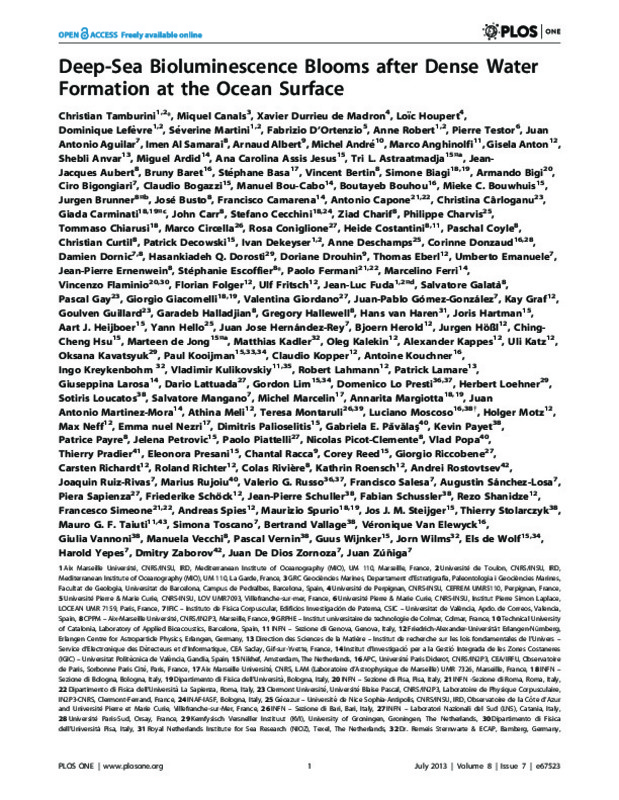|
Resumen:
|
[EN] The deep ocean is the largest and least known ecosystem on Earth. It hosts numerous pelagic organisms, most of which are able to emit light. Here we present a unique data set consisting of a 2.5-year long record of ...[+]
[EN] The deep ocean is the largest and least known ecosystem on Earth. It hosts numerous pelagic organisms, most of which are able to emit light. Here we present a unique data set consisting of a 2.5-year long record of light emission by deep-sea pelagic organisms, measured from December 2007 to June 2010 at the ANTARES underwater neutrino telescope in the deep NW Mediterranean Sea, jointly with synchronous hydrological records. This is the longest continuous time-series of deep-sea bioluminescence ever recorded. Our record reveals several weeks long, seasonal bioluminescence blooms with light intensity up to two orders of magnitude higher than background values, which correlate to changes in the properties of deep waters. Such changes are triggered by the winter cooling and evaporation experienced by the upper ocean layer in the Gulf of Lion that leads to the formation and subsequent sinking of dense water through a process known as "open-sea convection". It episodically renews the deep water of the study area and conveys fresh organic matter that fuels the deep ecosystems. Luminous bacteria most likely are the main contributors to the observed deep-sea bioluminescence blooms. Our observations demonstrate a consistent and rapid connection between deep open-sea convection and bathypelagic biological activity, as expressed by bioluminescence. In a setting where dense water formation events are likely to decline under global warming scenarios enhancing ocean stratification, in situ observatories become essential as environmental sentinels for the monitoring and understanding of deep-sea ecosystem shifts.
[-]
|
|
Agradecimientos:
|
This work was partially funded by the ANR-POTES program (ANR-05-BLAN-0161-01), ANTARES-Bioluminescence project (INSU-IN2P3), AAMIS project (Univ. Mediterranee), EC2CO Biolux project (CNRS INSU), Excellence Research Groups ...[+]
This work was partially funded by the ANR-POTES program (ANR-05-BLAN-0161-01), ANTARES-Bioluminescence project (INSU-IN2P3), AAMIS project (Univ. Mediterranee), EC2CO Biolux project (CNRS INSU), Excellence Research Groups (2009-SGR-1305, Generalitat de Catalunya), EuroSITES (FP7-ENV-2007-1-202955), MARINERA-REDECO (CTM2008-04973-E/MAR), HERMIONE (FP7-ENV-2008-1-226354), KM3NeT-PP (212525), ESONET NoE (FP6-GOCE-036851), DOS MARES (CTM2010-21810-C03-01) and CONSOLIDER-INGENIO GRACCIE (CSD2007-00067) projects. SM was granted a MERNT fellowship (Ministry of Education, Research and Technology, France). LH acknowledges the support of the Direction Generale de l'Armement (supervisor: Elisabeth Gibert-Brunet). The authors also acknowledge the financial support of the funding agencies: CNRS, CEA, ANR, FEDER fund and Marie Curie Program, Regions Alsace and Provence-Alpes-Cote d'Azur, Departement du Var and Ville de La Seyne-sur-Mer, France; BMBF, Germany; INFN, Italy; FOM and NWO, the Netherlands; Council of the President of the Russian Federation for young scientists and leading scientific schools supporting grants, Russia; ANCS, Romania; MICINN (FPA2009-13983-C02-01), PROMETEO (2009/026) and MultiDark (CSD2009-00064). The funders had no role in study design, data collection and analysis, decision to publish, or preparation of the manuscript.
[-]
|









